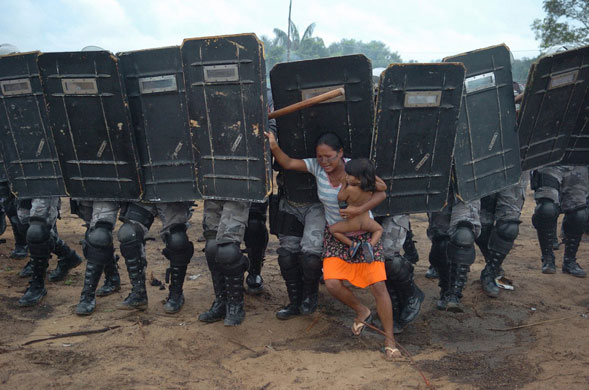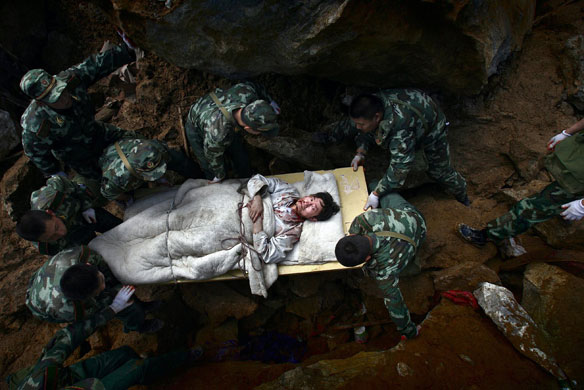ART PHOTOGRAPHS
Art Photography or Fine Art Photography refers to photographs that are created in accordance with the creative vision of the photographer as artist.

Minkkinen Arno Rafael, Le Bouquet d'Arbres, Malmo Castle Prison, Malmo, Sweden, 2007 Vintage silver print 8.5 x 5.75 inch, Courtesy Robert Klein Gallery

Christian Houge, "Oleg" C-print , 66 x 200 cm, Limited edition of 7 a Courtesy Christian Houge and ellen-k FINE ART PHOTOGRAPHY
PRESS PHOTOGRAPHS
Press Photography or Photojournalism is a particular form of journalism that creates images in order to tell a news story.

The general news singles category was won by the Brazilian photographer Luiz Vasconcelos, of Jornal A Critica/Zuma Press, showing a woman who tries to stop the forced eviction of her people in Manaus, Brazil, on 10 March, 2008.


Chinese photographer Chen Qinggang won first prize in the spot news singles category for "Rescue troops carry earthquake survivor, Belchuan County, China, 14 May."
DIFFERENCES & SIMILARITIES
One difference between Art Photography and Press Photography is that Art Photography seems to have little or no expression and, Rafael and Houge's photos clearly depicts this. The mood of the picture somewhat feels monotone and the feeling or thought that one feels when looking at these types of photographs seem linear. Art Photography makes viewers see what the photographer is seeing at a particular point in time. The image taken does not suggest any after thought or post-reflection on the picture. For example, if a photographer takes a photo of a tree, there is no other way to further expand on what you feel about the picture besides thinking if it is a nice tree or not. Press Photography is the opposite of this because these types of images provokes the viewer's mind and to make them feel a spectrum of emotions, which can be seen in both photos by Chen and Vasconcelos. Press Photography captures the emotions within its frame and makes viewers feel this strongly. It also allows viewers to think outside of the box and wonder what possible things, good or bad, are happening just by looking at the picture. Also in terms of titles, Art Photography tends to have the vaguest titles compared to Press Photography, which have detailed captions explaining the photo.
Another difference between Art and Press Photography is that there are guidelines that Press Photography have to abide to which are outlined by the NPPA (National Press Photographers Association). They are constricted to interfere with their subjects, unlike Art Photography, where most photographs are staged. There is more freedom associated with Art Photography because photographers are able to take photos and add an artistic touch to it. Press Photographers are not able to have this artistic touch. Their photos are simply based on their instincts, and their images are of the moment. Henri Cartier-Bresson, the godfather of photojournalism, even says that photojournalism is a speedy medium. Because they have to rely on their instincts, action shots are used often. Press Photographers are often in the middle of a conflict or a crisis, and sometimes in more come and peaceful situations. Art Photographers create the tone in their images.
ETHICS AND ART PHOTOGRAPHS
The whole idea of Art Photography is to alter the scene and/or the subject. It can be from adding objects into the scene or simply asking the subject to pose or do an action for the camera. Art Photographers also rely on digital imaging tools and a wide variety of other photography tools (different sets of lighting fixtures, flashes and lenses). Altering Art Photographs can include from changing the brightness, contrast, tint etc. of the image and this is ethical and accepted in the world of photography. However, it is not ethical to alter another photographers work without consent.
ETHICS AND PRESS PHOTOGRAPHS
As discussed previously, Press Photography is constrained by the NPPA to alter their images. They are allowed to make minor alterations, however, it must not affect the context of the photograph. Changing the photos also distorts the message of the image that is being shown by the photographer. Cropping something out of the photo is not allowed according to the NPPA. Westbrook says, "A shot of an individual rioter breaking a store window can look like an isolated act of criminality if the photojournalist does not show it in the context of a larger social event whose significance goes beyond the individual act." By altering a photograph, a photographer loses their integrity because they are providing a false image of the truth.
SOURCES
Friend, D. "Cartier-Bresson's Decisive Moment." The Digital Journalist. Retrieved 3 Nov. 2011 from <http://digitaljournalist.org/issue0412/friend.html>
"NPPA: Code of Ethics." National Press Photographers Association. Retrieved 3 Nov. 2011 from <
Westbrook, D. "A Brief History of Photojournalism." Photography Schools. Retrieved 3 Nov. 2011 from <http://www.photography-schools.com/photojournalismhistory.htm>
No comments:
Post a Comment